Knygotyra ISSN 0204–2061 eISSN 2345-0053
2022, vol. 78, pp. 163–193 DOI: https://doi.org/10.15388/Knygotyra.2022.78.111
The Bibliographical Maker Movement*
Courtney “Jet” Jacobs
University of California Library
Young Research Library, 280 Charles E. Young Drive,
North, Los Angeles, CA 90095, USA
E-mail: courtneyjacobs@library.ucla.edu
Marcia McIntosh
University of North Texas Libraries Digital Projects Lab
1155 Union Circle #305190, Denton, TX, 76203-5017, USA
E-mail: marcia.mcintosh@unt.edu
Kevin M. O’Sullivan
Texas A&M University
5000 TAMU, College Station, TX, 77843-5000, USA
E-mail: kmosullivan@library.tamu.edu
* Authorship of this article was shared in equal collaboration; attribution is thus listed alphabetically.
Summary. At the end of the twentieth century, increased access to certain technologies and processes, such as 3D scanning, computer-aided design, rapid fabrication and microcircuitry, enabled consumers to become creators of material design. These activities, which collectively came to be known as making, extended across both public and private sectors, including the study of the book. This paper offers an extended discourse on the full range of activities comprising the bibliographical maker movement, which in recent years has coalesced around the idea that maker culture may be employed to enhance our understanding of not only the history but also the future of the book. The application of these new technologies toward critical book studies has proceeded from the practice-based approach to research and instruction first begun under the auspices of the bibliographical press movement in the mid-twentieth century. In keeping with this earlier work, biblio-making is predicated upon the idea that certain kinds of knowledge are best gained through personal experience and experimentation. This article will first outline the benefits of applying 3D technologies to the goals of book history before locating and describing the activities of participating individuals and institutions within three broad categories: holistic, 3D digitisation; recovering historical tools and processes; and creative experiments in book design. As the article demonstrates, the strength and potential of the bibliographical maker movement lies in its widening community of practice and that, by virtue of its being an open-access network of constituents, it is now poised to make a significant and lasting contribution to the study of the book.
Keywords: Bibliography, maker culture, book history, 3D technologies, bibliographical press movement, bibliographical maker movement, artists’ books
Spausdinimo senosiomis spaudos staklėmis judėjimas
Santrauka. XX a. pabaigoje padidėjusi prieiga prie tam tikrų technologijų ir procesų tokių kaip 3D skenavimas, kompiuterinis projektavimas, sparti gamyba bei mikroschemos leido vartotojams tapti medžiagų dizaino kūrėjais. Ši veikla, kuri apibendrintai pradėta vadinti „kūrimu“ (angl. making), apėmė viešąjį ir privatų sektorius, įskaitant knygų tyrimus. Šiame straipsnyje pateikiamas platus visos veiklos spektro diskursas, apimantis spausdinimo senosiomis spaudos staklėmis kūrėjų judėjimą, kuris pastaraisiais metais susiliejo su idėja, skelbiančia, kad kūrėjų kultūra gali būti pasitelkta siekiant pagerinti mūsų supratimą ne tik apie knygos istoriją, bet ir jos ateitį. Šių naujų technologijų taikymas kritiniams knygų tyrimams kilo iš praktika pagrįsto požiūrio į tyrimus, o mokymai pirmiausia buvo pradėti XX a. viduryje pasitelkiant spausdinimo senosiomis spaudos staklėmis judėjimą. Remiantis šiuo ankstesniu darbu, knygų kūrimas grindžiamas idėja, kad tam tikras žinias geriausia įgyti per asmeninę patirtį ir bandymus. Šiame straipsnyje pirmiausia apibūdinami 3D technologijų taikymo knygų istorijos tikslams pranašumai prieš nustatant ir aprašant dalyvaujančių asmenų ir institucijų trijų plačių kategorijų veiklą: holistinę, 3D skaitmeninimą; istorinių įrankių ir procesų atkūrimą; kūrybinius knygų dizaino eksperimentus. Kaip rodo straipsnis, bibliografijos kūrėjų judėjimo stiprybė ir potencialas slypi besiplečiančioje aktyvioje bendruomenėje, o kadangi tai yra atvirosios prieigos elementų tinklas, tai dabar ji pasirengusi įnešti reikšmingą ir ilgalaikį indėlį į knygų tyrimą.
Reikšminiai žodžiai: knygos istorija, kūrėjų kultūra, knygos istorija, 3D technologijos, spausdinimo senosiomis spaudos staklėmis judėjimas, spausdinimo senosiomis spaudos staklėmis kūrėjų judėjimas, menininkų knygos.
Received: 2021 11 07. Accepted: 2022 02 23
Copyright © 2022 Courtney “Jet” Jacobs, Marcia McIntosh, Kevin M. O’Sullivan. Published by Vilnius University Press. This is an Open Access journal distributed under the terms of the Creative Commons Attribution Licence, which permits unrestricted use, distribution, and reproduction in any medium, provided the original author and source are credited.
Introduction
In 1965, British bibliographer and librarian Philip Gaskell coined the term ‘Bibliographical Press Movement’ to refer to the increasingly popular approach of seeking to understand historical book production through experiential research and learning. This approach of replicating historical methods while engaging in critical enquiry through practice created a lasting legacy with many taking up this work through the turn of the twenty-first century. Simultaneously, another community of practice invested in learning through doing arose alongside the increased availability of emerging technologies like 3D scanners and 3D printers, evolving into what is now known as the ‘maker movement’. At the nexus of these two groups emerged ‘The Bibliographical Maker Movement’, which in recent years has coalesced around the idea that rapid fabrication technologies may be employed to enhance our understanding of not only the history but also the future of the book.
This paper attempts to define the bibliographical maker movement through an extended consideration of the full range of activities which apply maker technologies to the study of the book. As we will demonstrate, this new technological approach to critical book studies has proceeded from the research and instruction in the field of book history first begun in the mid-twentieth century. Following Gaskell’s model, the present article will first outline the benefits of applying 3D technologies to the goals of book history before locating and describing the activities of participating individuals and institutions. Ultimately, we will argue that, like the bibliographical press movement before it, the strength and potential of the bibliographical maker movement lies in its community of practice and that, by virtue of its being an open-access network of like-minded constituents, it is now poised to make a significant and lasting contribution to the study of the book.
Philip Gaskell and the Bibliographical Press Movement
In his landmark article, ‘The Bibliographical Press Movement’, Philip Gaskell gave a name to a growing trend in historical book research and instructional practice. What began tentatively in 1927, when the first bibliographical press was founded by Carl P. Rollins at Yale University, had by then become an international ‘boom’ across universities in the English-speaking world.1 This led Gaskell to investigate ‘what purpose all these bibliographical presses are intended to serve; whether they succeed in serving it; and how their sudden proliferation can be explained’.2 In so doing, he defined the goals, practices, and major stakeholders of the bibliographical press movement as it existed at the time. However, he also charted a path describing how such a printing press might be established, which later followers would subsequently take up.3 Indeed, bibliographical presses continue to appear in libraries and university departments with remarkable regularity and success to this day.
According to Gaskell’s survey of his contemporary practitioners, the goals of the bibliographical press movement were in support of instruction related to historical printing: setting type by hand and (for most) printing from that type upon a historically sympathetic press. For Gaskell, the pedagogical value of press work derives both from the product as well as the process: ‘Even mistakes made by pressmen can have bibliographical significance, and – as with composition – there is no better way of recognising and understanding such mistakes than that of making them oneself’.4 Indeed, he acknowledges that the quality of printing produced within these settings was often quite poor, choosing to focus instead on the physical processes as the source of practical knowledge. He laments when practitioners choose to cut corners for the sake of ease, stating, ‘Certainly it is easier to [only print on one side of the sheet and use a ‘french fold’] than to go to the trouble of making register and perfecting, but it doesn’t teach you so much’.5 It is this emphasis on the knowledge that may only be gained through personal experience and experimentation which made the bibliographical press movement so successful and so enduringly appealing to new generations of book historians.
Beyond this practical knowledge, however, Gaskell’s case for such hands-on work argued for a wider appeal. In addition to a better understanding of the practices of early modern printing houses, Gaskell also identifies a second group of motives driving the work of the bibliographical press movement: namely, those who ‘may be interested in the development of bibliographical techniques for their own sake [...] or in the history of the technological or typographical development of the printing trade’.6 Finally, Gaskell advocates a still broader use case for the bibliographical press than these two specialised groups of scholars. For many students, he contends, devoting significant class time to studying the finer points of the compositor’s trade and other pressroom minutiae would prove an ‘unreasonable [...] bother’.7 However, there is great potential for such a lay audience in experiencing a live exhibition using these tools and materials:
A demonstration of a hand-press room and its equipment, with a brief talk by way of explanation, can be of great interest and value to undergraduates in either literature or history. For most people, a few minutes in which printing equipment is actually seen in use is worth more than hours of reading textbooks about it.8
Here, Gaskell underscores the lasting pedagogical value of personal engagement – beyond and in addition to first-hand experience – with the technology and practices of historical book production.
As we have argued elsewhere, the increased activity of book historians in digital spaces, coupled with the availability of affordable 3D technologies has given rise to another ‘boom’ (to borrow Gaskell’s phrase) of innovative practice-based research and instruction related to the history of the book – one we have termed the bibliographical maker movement.9 In the remainder of this paper, we will outline three emerging approaches to this work. In their efforts to elucidate and understand the history of the book, bibliographical makers are using 3D technologies to expand digitisation of historical materials. Likewise, these new tools are being employed to recreate tools and processes, which in turn offer experience in design and new insights into historical book production. Finally, bibliographical makers are also actively involved in forecasting possible futures of the book, experimenting with innovative technologies and materials to intensify the relationship between form and meaning.
The Evolution of Digitisation
In the early twentieth century, new photographic technologies made it possible to reformat and distribute copies of rare books and manuscripts at scale for the first time. Earlier technologies, such as the Autotype, demonstrated the viability of publishing photo-facsimiles. However, wide distribution of these texts only became available thanks to the vision and ambition of entrepreneurs like Eugene Power, who applied the emerging technology of textual microphotography to the preservation and dissemination of rare books. Power, who went on to found University Microfilms, Inc., is today best known for his role in popularising microfilm copies of rare books, which were sold to libraries and other cultural institutions around the world. His revolutionary idea was ‘to publish any text material in existence in editions of any size, at any time and at low cost … [to be] reproduced, on demand, in editions numbering as low as one’.10 This work would prove immensely influential across academia, paving the way for subsequent ventures like Early English Books Online (EEBO), as well as large-scale scanning projects like Project Gutenberg and Google Books.
Through microphotography, the book is reduced to a static, two-dimensional plane. In other words, it is flattened, thus affording a great privilege to the text over its material substrate. During World War II, when these efforts began in earnest, Power and others like him were racing to preserve endangered works, which survived in only one or two copies. A similar, albeit less grave, impetus would drive the Brittle Books Program, funded by the National Endowment for the Humanities (NEH) in the United States. The pervasive use of highly acidic wood-pulp paper during the late nineteenth and early twentieth centuries had created an urgent problem in which many paper-based objects, including books, were rapidly decaying to the point of extreme fragility. In 1988, following the realisation of this problem, the NEH launched an ambitious initiative to microfilm three million books over twenty-one years.11 While these efforts did important work in their respective eras to capture important early texts, it would be incorrect to declare these books as having been captured or reformatted in their entirety. As Jentery Sayers has written, ‘Books, buildings, sculptures, environments, and innumerable others are flattened in the interests of reference. They become texts without texture or substance without substrate’.12 For book historians and others who are invested in the material culture of writing, these two-dimensional scans have long felt inadequate.
Historically, reformatting projects have placed an outsized value on the texts conveyed by the physical object. Indeed, reformatting is defined by its promise to remove information from its native medium and reproduce it in another, leading many to the faulty conclusion that a text may be faithfully dissociated from its container – a topic that will be addressed more fully later in this article. As David Pearson notes, ‘The ways in which books are made, owned, written in, mutilated and bound all add something to the documentary heritage which is central to the record of human civilisation.’13 This is not to diminish the great service performed by such projects, which create broad access to valuable cultural materials. However, we do well to be mindful of how texts change when they are scanned, and to strive for transparency in our contemporary reformatting projects. Historically, in the mass digitisation completed by information repositories, digitisation technicians prioritised the content of the book rather than its import as a physical object. Thus, many visual aspects of books – covers, spines, watermarks, endsheets – are erased from the digitised surrogate. Divorcing information from its container erases the evidence of the object’s making, obscuring not just the physical materiality but the evidence of the individual and cultural conversations that both necessitated and fulfilled the object. Today, more than ever before, we have an opportunity to fully attend to the form of a book and what it communicates alongside the text it conveys while creating a new digital representation. Barbara Laufersweiler, Director of Digital Collections and Digitisation at the University of Oklahoma, discussed the idea in her presentation ‘Beyond the Pages: Early Printed Books in Digital Collections’ that ‘practical, low-cost, high-impact practices’ in digitisation could allow ‘digital library users to engage with early printed books more fully’ and ‘allow the books to be available for new scholarship and engagement.’14 Laufersweiler thus encourages digitisation professionals to make the small extra effort to collect these features either in images or through the metadata.

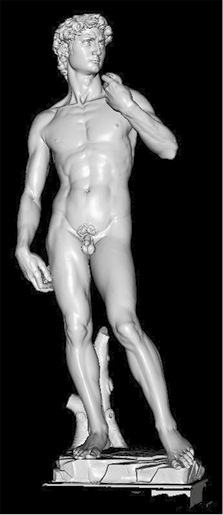
Figure 1: An artificially-colored 2mm laser scan15 (left) and 3D rendering (right) of David by Michelangelo16
Since Eugene Power’s initial wartime reformatting efforts, the technologies supporting digitisation projects have continued to progress, greatly expanding the types of material that can be successfully captured. While the content of a scanned modern technical report may be explored in two-dimensional images without much loss, a finely textured three-dimensional object, such as a statue or jewelled binding, can only be partially experienced in the traditional method via a series of 360-degree photographs. At the end of the twentieth century, however, non-contact and less invasive 3D scanning technologies began to be employed in the service of digitising fragile and valuable cultural heritage artifacts. Although 3D scanning such objects reportedly began as early as 1996 with the National Research Council of Canada, in 1997, a Stanford University Team led by computer scientist Marc Levoy started planning one of the largest and most notable 3D scanning efforts: the Digital Michelangelo Project (see Figure 1). The aim here was ‘to advance the technology of 3D scanning, to place this technology in the service of the humanities, and to create a long-term digital archive of some important cultural artifacts.’17
They executed nearly a year’s worth of 3D scanning in Italy between September 1998 and June 1999. The project, alongside many other pioneer efforts, has produced an expanding field of artifact-safe 3D capture methods including photogrammetry, structured light scanning, laser scanning, and 3D modelling. However, this technology need not be confined to easily identifiable three-dimensional objects, but allows for a raising of those bibliographical materials once considered and treated flatly.
Several institutions have embraced a holistic approach to book-object digitisation. The Munich DigitiZation Center (MDZ) uses infrared scanning to capture watermarks within the materials it digitises. In a video on their website,18 viewers can see the scanner and process of digitising watermarks19 and 3D digitisation of spaces and larger objects.20 MDZ also uses 3D digitisation to capture unique physicality in specific books such as the Sakramentar Heinrichs II sacramentary, the binding of which boasts a silver plate depiction of Pope Gregory the Great (590-604) and provides an excellent example of the intricacies of Ottonian book art.21 A second example, the Fuladaer Sakramentar manuscript,22 is crafted with golden clasps and Carolingian ivory reliefs on the front and back covers depicting the Life of Christ (see Figure 2).
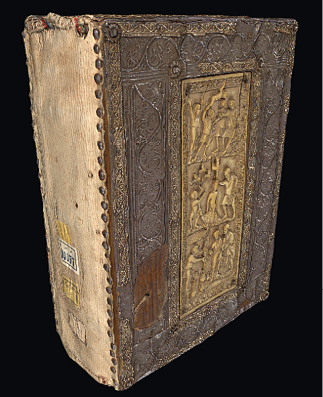
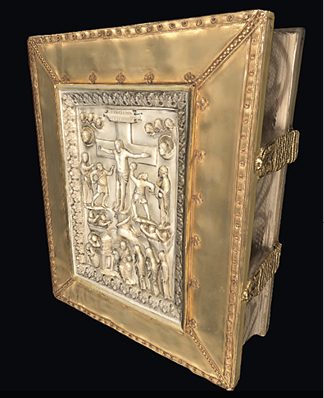
Figure 2: Images of Fulda Sacramentary – BSB Clm 10077 (left) and Sakramentar Heinrichs II. – BSB Clm 4456 (right) 3D models from the Bavarian State Library.
Similarly, the British Library has also fully captured certain books, such as a fifteenth-century bound manuscript23 and a seventeenth-century scroll24 from their collections. Both objects convey a manuscript copy of the same text – the biblical book of Esther (see Figure 3). However, each provides unique, valuable information on how the text was presented, interpreted, and valued. For instance, the earlier manuscript had first been presented as a scroll, as was customary since the talmudic period, but was later cut into sheets and bound in its current codex form. In an article describing the Hebrew manuscripts’ digitisation British Library staff members Kristin Phelps and Adi Keinan-Schoonbaert emphasise that books are ‘not just vehicles of information’, but are simultaneously three-dimensional objects, which convey important details regarding their manufacture, ownership, and treatment history.25
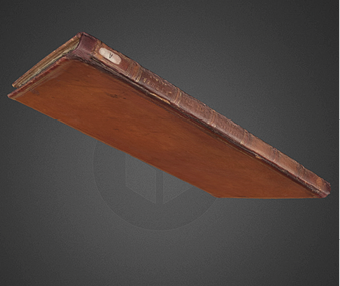
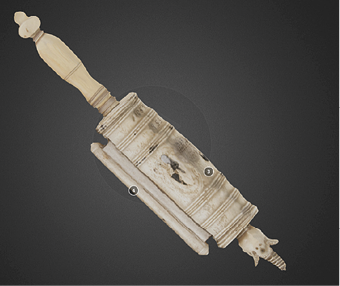
Figure 3: 3D models of a bound manuscript and scroll of the Book of Esther from the British Library Sketchfab collection.
Perhaps the earliest format for books or book-like objects was the tablet, the best- known being the Rosetta Stone. Its study, including the recent online exhibit ‘All Good Things Come in Threes’,26 presents a compelling perspective of the ‘book’ as being more than text. An upright stone slab, or stela, containing engraved text communicating decrees by Egyptian king Ptolemy V (210-180 BCE), the Rosetta Stone’s influence also extends to the birth of Egyptology as a field. Its description led to the deciphering of Ancient Egyptian hieroglyphic language in 1822 by Jean-François Champollion. Since then, scholarship around the stone has expedited language learning and facilitated further discussions on the handling of ancient and modern cultural artifacts. It also provides a fantastic example of the application of 3D technologies in bibliographical studies.
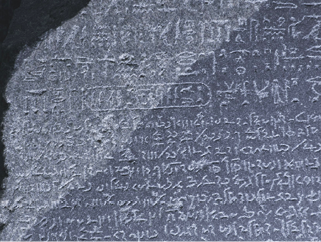
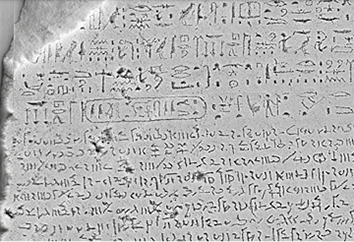
Figure 4: Photos of the Rosetta Stone (top) set alongside the Rosetta Stone Depth Map (bottom).27
While the original is currently on display and viewed by over six million visitors at the British Museum, the Rosetta Stone has been duplicated via four high-quality copies and several casts. Rosetta, the city in Egypt whence the English acquired it, also has a copy on display. The advent of the digital age has dramatically increased access to the stone. In the past, photographs taken from both inside and outside of the stone’s protective glass barrier failed to capture the detail of the three languages on the deep black granodiorite stone. This changed in June 2018 when computer scientist Angelos Barmpoutis took eight photos from different lightings and used an algorithm to create a depth map28 of the stone, currently the highest resolution capture and the clearest of the stone’s language to date (Figure 4). Previous mediations had been attempted to make the text of the Rosetta Stone more legible, including rubbing it with white chalk.29 The 3D digitisation of these items could not only preserve this overlooked information, but also pave the way for post-custodial digitisation or repatriation of objects to their heritage communities.
As we have demonstrated, cultural heritage institutions have successfully applied 3D technology to enhance access to collection materials. However, as University of Victoria professor Jentery Sayers has pondered, ‘When an old technology is neither in the archive nor ready to hand, how do we learn how it was manufactured? How and by whom it was used? How and for whom it failed? How and under what assumptions it was deemed obsolete and discarded?’30 In the next section, we will illuminate the critical intersection of making and practice-based learning, especially with regard to the documentation, consumption, and transmission of culture.
Remaking History
Philip Gaskell challenged scholars to employ a practice-based approach in their pedagogy, arguing for the benefit of applying hands-on use of various analogue technologies to understand book history. Thus the bibliographical press movement can be interpreted as having promoted tinker-centric pedagogy, or tinkering as a way of knowing, since its inception. Utilising historical technologies, as well as scrutinising their products, provides a lens through which we can more fully understand various cultures of the past and their craftsmanship.
In researching historical printing tools and practices, Gaskell and others relied heavily on the second volume of Joseph Moxon’s Mechanick Exercises: Or The Doctrine Of Handy-Works (1683-4).31 Twentieth-century scholars considered this thorough manual covering all aspects of typecasting, composing, and press-work as ‘the first, the most detailed, and (on the whole) the most accurate description of the practice of typefounding and printing.’32 Some scholars have argued that Mechanick Exercises was probably not a handbook aimed at the itinerant trade worker at the time of publication.33 Rather, its audience was the burgeoning academic elite interested in studying the techniques of various business arts in an attempt to improve the efficiency and profitability of industries such as printing. This text, as well as later printing manuals, served as a critical resource for investigating historical printing practices in the west as well as the specifications to fabricate the tools needed to facilitate experiential learning.
In 2016, a five-student team at Rochester Institute of Technology designed and reconstructed a wooden common press to fill a gap in The Cary Graphic Arts collection of historic presses. In detailing the project’s impetus, the team members note that ‘[f]ewer than 90 wooden presses produced prior to 1820 still exist, and all of them [are] held by institutions. Barring the chance of one coming up for sale, the next best option for ownership is to make one.’34 The team members came from a variety of academic backgrounds, including design and museum studies, as well as mechanical, industrial, and systems engineering. Together, they conducted extensive research using printed literature and diagrams as well as numerous field trips to study period-specific presses in the United States and England. In so doing, the team encountered challenges faced by many during the height of the bibliographical press movement, including difficulty sourcing materials, locating and communicating with craftsmen engaged in both woodworking and blacksmithing, and shaping the spindle or ‘heart of the press’. For example, their designs and drawings had to be translated for production by the blacksmith, rather than a modern machine shop, and dimensional standards had to be adjusted. They report:
Producing metal parts became a conversation, and each side had to give and take. Sometimes, the team used modern shop practises in conjunction with blacksmithing in order to produce satisfactory parts. Parts were outsourced to the machine shop and [...] sent to the blacksmith to be blackened for historic, handmade finish.35
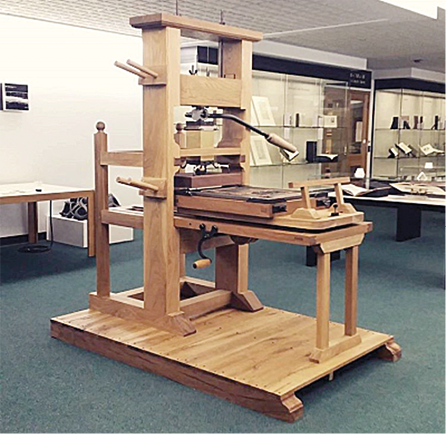
Figure 5: Complete 18th-century Wooden Common Press by RTI Engineering Students.36
Though heavily data-centric, the team’s approach is similar in many ways to other reconstruction projects undertaken throughout the twentieth and twenty-first centuries. Many of the individual parts were designed using measurements gathered during site visits as well as reference materials found in Moxon and other printing manuals. To augment this work, however, the team utilised 3D modelling and fabrication technology to test fit across prototype designs (Figures 5 and 6) as well as conduct stress analysis. Thus, the team took a hybridised approach in applying maker technologies to the production of historically accurate tools, blending early modern and twenty-first century notions of craftsmanship.
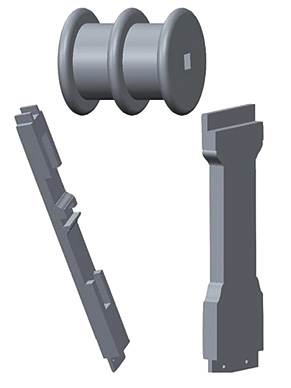
Figure 6: 3D modelled prototype pieces from the common press reconstruction project undertaken by Engineering students at the Rochester Institute of Technology in 2016.37
Many engaged with biblio-making initiated similar projects in order to fill gaps in institutional or personal tools collections. As Sayers notes, ‘fabricating historical artefacts in the present affords an awareness of transduction in the past, especially when those artefacts are not accessible (e.g. they cannot be viewed, heard, handled, or digitised).’38 The 3Dhotbed (3D History of the Book Education) project began as a collaborative, multi-institutional exploration into how 3D scanning, modelling, and printing technologies may facilitate affordable access to book history-related teaching tools. Although it began with the initial goal of designing a teaching toolkit in support of instruction related to historic typecasting, the greater potential of utilising maker technologies in support of furthering our understanding of material culture was quickly confirmed through the support of a broader community of biblio-makers (and those exploring the intersection of experiential learning and 3D technology more generally). Through interactions with teaching faculty, 3D modellers, researchers, engineers, papermakers, and design enthusiasts, the project has now grown into a collaborative international community of practitioners. In response to the project’s initial efforts, scholars and hobbyists reached out with ideas for further development, suggestions for improvement, and in some cases datasets of their own, hoping to contribute to the growing corpus of a digital humanities project centred on the importance of experiential hands-on enquiry into the tools and processes of historical book making.
The current collection of 3D printable tools continues to expand as the project connects to additional scholars, modellers, instructors, and hobbyists. The typecasting teaching toolkit includes a two-part adjustable hand mould, a punch, a matrix, a complete piece of type with an attached jet, as well as a two-part piece of type with a removable jet. The 3Dhotbed collection also includes datasets to print various woodcuts, a miniature functioning printing press, and three versions of a functioning papermould that can be used to create sheets of hand-laid paper measuring 4.25 by 5.5 inches [10.8 x 13.97 cm]. To complement the typecasting teaching toolkit, the team is currently finalising a typesetting teaching toolkit that will include multiple dataset collections that can fabricate various assemblages of individual type pieces and spacing material along with a fixed-rule composing stick. Once printed, this kit will provide the opportunity to practice setting individual lines of type, character by character, paying attention to spacing, spelling, justification, and to learn from the inevitable compositors’ errors.
The printing press included in the 3Dhotbed collection produces a miniature-scale working replica of a European style common press similar to those used during the hand-press era, in which a screw transmits pressure through the platen to create an even imprint onto an inked surface. Developed by Alex Wingate and her father John Wingate, the press stands 6.5” tall by 3.85” wide and 6” long [16.51 x 9.78 x 15.24 cm], and with a working area of about 2.35” by 1.7” [5.97 by 4.32 cm]. As a student of librarianship and bibliography, Alex asked her father (an engineer and 3D printing hobbyist) to 3D print a miniature press from a publicly available dataset on his home printer. The resulting model was static and could not produce prints. In the interest in fabricating a working press, Mr. Wingate researched and modelled his own. In addition to producing historically accurate mechanisms, the design process for the Wingate press also involved investigating and developing alternate pieces for certain sections of the press to improve functionality. Similar to the previously mentioned RIT project, describing and ingesting the Wingate press into the 3Dhotbed collection required developing a shared language across fields of study, translating engineering terms into book history terms and vice versa. In addition to providing affordable access to hands-on tools for teaching and research, this and similar projects enhance the potential for historical research while broadening the audience for cultural heritage materials.
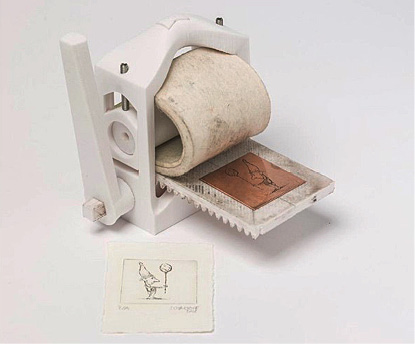
Figure 7: 3D printed and assembled Open Press with a completed engraved print.39
Like experience in letterpress printing, many illustrative printmaking processes remain inaccessible to those not aligned with universities, printmaking studios, or other private institutions capable of purchasing and maintaining presses. In an attempt to remedy this, Martin Schneider and Dominik Schmitz designed and modelled a dataset capable of printing a miniature functioning etching press (see Figure 7).40 Established in 2018, the mission of the Open Press Project is to facilitate people’s ability to ‘create art in places where printmaking wasn’t possible before.’41 Anyone can download and 3D fabricate pieces that, once assembled with easily acquired M5 screws and matching hexagonal nuts, become a fully functioning table top etching press to produce a 75 by 145 mm print. Like other tabletop presses, the Open Press provides the tools necessary to disseminate information more rapidly, thus helping consumers to become creators. But the Open Press Project, as well as other related endeavours, utilises readily available 3D technology to engage artists in historical printmaking and illustration practices.
Just as scientists utilised Moxon’s text in the seventeenth century to investigate the efficiency of tools and processes during the hand-press era, today’s biblio-makers approach book history from various disciplines and apply modern technology and theory. As Sayers points out, conducting research in 3D spaces ‘expands how primary objects can be perceived, allowing researchers to stitch together evidence into historically unique models and prototypes.’42 A major asset for the continued growth of the bibliographical maker movement is the proliferation of 3D technologies through which interested parties can not only explore replicating historical tools and processes, but they can also engage in their design. As such, the bibliographical maker movement is not tied to current interpretations of past technologies or existing historical models; a biblio-maker gains knowledge from research, interpretation, and the iterative process of not only re-engineering these tools, technologies, and artifacts, but perhaps developing something new as a result.
Productive Futures of the Book
Following the digital turn of the late twentieth century, numerous cultural critics and techno-evangelists forecast the ‘death of the book.’ Such opinions, which continue to proliferate even today, are often predicated on an evolutionary or supersessive view of technology. They predict that something new will supplant and replace something old, improving upon it and thus rendering it outmoded and largely irrelevant. This view of media advancement did not arise with digital technology. Historical accounts of media change tend to value novelty and seek to locate a technology’s point of origins. As Lisa Gitelman argues, ‘looking into the novelty years, transitional states, and identity crises of different media stands to tell us much, both about the course of media history, and about the broad conditions by which media and communication are and have been shaped.’43 Paul Duguid has argued for a more nuanced consideration of technological change, writing, ‘To resist simple ideas of supersession […] encourages richer investigation of those very genealogies supersession makes untraceable.’44
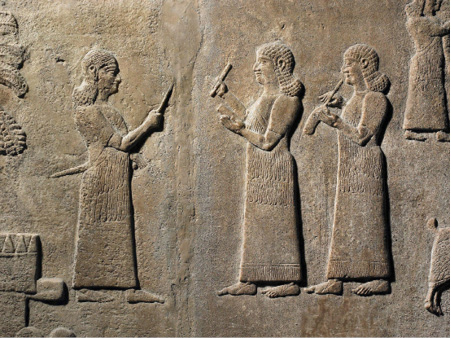
Figure 8: Alabaster wall panel relief depicting two clerks, 728 BCE, British Museum.45
Examples documenting the comingling of writing technologies appear throughout the historical record. For instance, an alabaster wall panel from 728 BCE, now held by the British Museum, depicts an Assyrian King, Tiglath-Pileser III’s campaign in Babylonia (see Figure 8). In the relief, Assyrian clerks record details of the campaign and subsequent mass deportation. One clerk holds a clay-tablet and a stylus, making his record in cuneiform; his colleague, the writer of Aramaic, uses a pen-like object to write upon a scroll of what is thought to be leather or parchment. The relief bears witness to what medievalist scholar Jennifer Brantley has described as a more complex ‘media ecology’. Writing of the Middle Ages, she argues ‘[t]he multiplicity of medieval media and their complex intermedial interactions offer a reminder that media forms are always shifting fundamentally in horizontal ways, based on spatial and social landscapes, as well as in vertical ways, based on the idea of historical supersession.’46 As Brantley demonstrates, in these transitional periods of media change, technological influences flow freely between the old and the new. This is true in the interactions between orality and literacy during the Middle Ages and is equally visible in the interactions between the physical and digital books of our own age.
Futurological forecasts of the obsolescence of the physical book often point to the popular adage that ‘information wants to be free’. The full quote, first uttered by Stuart Brand at the 1984 Hackers’ Conference and subsequently published in The Media Lab: Inventing the Future at MIT, adds ‘Information also wants to be expensive’.47 However, its more popularised incarnation implies that the form of the book is not only distinct from the textual information it contains, but antagonistic to it as it prevents the natural transmission between author and reader. As Duguid argues, however, this presents a false dualism between information and technology. He advocates for a ‘more productive’ view of books (and media in general): ‘It is more useful to consider information and technology as mutually constitutive and ultimately indissoluble [...] not independent, but interdependent.’48 Brantley offers a similar insight. She allows that ‘the isolation of the matter from the manner is the beginning of talking about manner’ and that ‘one has to separate them to see the importance, or even to acknowledge the existence, of media forms’.49 But ultimately, she argues that ‘we should not separate medium from meaning’, for ‘it is in fact impossible to talk about meaning without taking medium into account’.50 This debate has created an opportunity for artists and makers to consider the ability of a book’s physical presence to create meaning in today’s culture.
Writing at the end of the twentieth century, Johanna Drucker affirmed ‘The culture of the book is our future, our continued work a legacy across time and space, a continuation of an ongoing tradition.’51 At a moment when personal computing and other popular digital technologies were ascendant, she predicted: ‘Paper may become precious, printing technology transform, and production methods expand – but the potential of the book as a creative form will remain available for exploration.’52 In her pioneering study, which remains the canonical text on the genre of artists’ books, Drucker offers a sustained meditation on the seemingly inexhaustible potential for the form of a book to construct complex meanings: ‘Artists’ books take advantage of the efficiency of the codex and its capacity to contain considerable quantities of information (visual, verbal, literal and metaphoric) in a workable form.’53 In comparison with other twentieth-century artforms – as well as contemporary bibliographic genres – the artist’s book offers a uniquely self-reflexive construct of meaning, entirely preoccupied with its own bookness as well as the long tradition of book culture that precedes it. As an aesthetic object, the artist’s book asserts the primacy of the object’s physical – and, at times, almost sculptural – form as a site for meaning making. Thus, it disrupts the oppositional dichotomy asserted by many between form and content. Indeed, one measure of the success of an artist’s book is how dynamically the intellectual content and physical production are integrated.54
In charting the rise of this important artform, Drucker attests that increased access to affordable printing technologies as well as a growing acceptance of new media forms among artists during the postwar era are largely responsible for the boom in creative output among book artists during the late twentieth century.55 Equally important for the growth of the genre was the ‘desire to make a voice heard, or a vision available’ among artists – a kinship it shares with the contemporary rise of independent publishing and, more recently, the do-it-yourself (DIY) ethos of maker culture.56 Given these shared proclivities, it is perhaps unsurprising to find that recent book artists have made significant use of maker technologies, such as 3D printing, and alternative distribution networks, such as Thingiverse, to create and distribute their work.
In 2013, artist and educator Tom Burtonwood produced what he claims to be the world’s first 3D-printable book, Orihon, which employs 3D scans of sculptures and reliefs from the Art Institute of Chicago, The Metropolitan Museum of Art, the American Museum of Natural History in New York, and The Field Museum in Chicago, bound together in an accordion book structure using all 3D-printed parts. Though the work was published in a signed edition of fifty copies, anyone is free to download, share, or reuse Burtonwood’s data, which is freely available on Thingiverse. In his artist’s statement Burtonwood writes,
As the sampler was to hip-hop so the 3D printer is to sculpture and designed objects. Open source 3D printing has paved the way for a revolution in making things. Just as blogs disrupted publishing, and smart phones changed communications, so 3D printing, scanning and modelling will transform the world of objects and the services that surround them.57
In its use of scanned source material, Orihon engages with the promise of maker technologies to democratise access to objects of cultural heritage. Burtonwood took up this theme again with Folium (2014), which appropriates 3D scans of artworks found at the Art Institute of Chicago in a traditional codex form. Extending the concept of democratised access to art, this book additionally includes braille translations of text within the book ‘to aid recognition for the low sighted and visually impaired’.58 In a similar mode, Burtonwood produced Twenty Something Sullivan (2016) in collaboration with City of Chicago Cultural Historian Tim Samuelson, a circular book featuring 3D scans of nine architectural ornaments produced by notable architect Louis H. Sullivan in his early career.59
At approximately the same time that Tom Burtonwood began publishing his editions, Bill Westheimer began an ongoing conceptual 3D-printed artist’s book series titled Gutenberg. The several books included in the series comprise a sustained meditation upon the relationship between technology and information and how the format of the book continues to evolve. As Westheimer has stated in an interview, ‘Books are simply a way to share ideas and images and the form they take has been revolutionised by modern technology. These 3D printed books are my commentary on that transformation.’60 An illustrative example is his Complete Works of William Shakespeare (2014), which includes an electronic text of Shakespeare’s oeuvre on a USB drive sealed within a 3D-printed codex form. In his artist’s statement, Westheimer writes:
In today’s world, books are evolving into different formats. Some people find that digital books are undesirable, others embrace them. This book is a digital-3D printed book shaped vessel which cannot be opened. There is a printed title page and author portrait. The book cannot be read without destroying the book.61
This relationship between form and content is a topic Westheimer has explored elsewhere as well, such as the 3D-printed limited edition artist books, Manual (2014) and Visions In the Dark (2014), each of which also includes an inaccessible text. As he has written elsewhere, ‘The Gutenberg series of 3D printed book shaped sculptures deals with the evolution of books and how knowledge may be distributed in the future [...] These books require the viewer/reader to trust the artist – is the content really in there or not? You can see something is inside but you don’t know if it is really as the artist claims.’62 By rendering the text unreadable, Westheimer precludes the reader from passively engaging with the book form: They are forced to contemplate their role in the activation of the text by choosing whether or not to destroy the book’s conceptual sculpture. Thus, the reader’s attention is irrevocably drawn to the physicality of the book insofar as it obstructs their interaction with any other element of the text.
In recent decades, academic professionals working in areas like conceptual design and critical making have also entered this rich dialogue exploring the physical book’s potential for meaning-making, building upon the established tradition of artists’ books. Matt Ratto, who was among the earliest practitioners of critical making, has described this practice as ‘a mode of materially productive engagement that is intended to bridge the gap between creative physical and conceptual exploration’, the goal of which is ‘to supplement and extend critical reflection and, in doing so, to reconnect our lived experiences with technologies to social and conceptual critique.’63 The critical making approach involves three components, which need not proceed in any order: 1) Relevant literature is reviewed, and useful concepts and theories are compiled; 2) Technical prototypes are jointly designed and built by involved stakeholders; 3) The group examines and reflects upon the prototypes, the ideas they express or engage, and reconfigure as appropriate. What is perhaps most notable about Ratto’s elements of critical making is that each is social. Prototypes are conceived, designed, critiqued, and revised communally among the students, scholars, and/or stakeholders participating: ‘Critical making emphasises the shared acts of making rather than the evocative object. The final prototypes are not intended to be displayed and to speak for themselves. Instead, they are considered a means to an end, and achieve value through the act of shared construction, joint conversation, and reflection.’64 Like any form of textual transmission, this process relies upon a shared community of knowledge to which the object (as well as the process by which it was created) is legible and meaningful.
Within the academy, approaches similar to that which Ratto describes have been fruitfully embedded as part of undergraduate and graduate courses related to book studies. For example, Kathryne Beebe has offered the students of her History of the Book course a choice between a traditional seminar paper and a creative bookmaking project for their final deliverable work. The latter was designed in partnership with her counterpart in the FabLab at the University of Texas at Arlington, Morgan Chivers, who describes the students’ experience in Maker Literacies: ‘Students who chose the maker term project were prompted to create a cultural artifact that meaningfully engaged with some aspect(s) of the technological and conceptual changes in literate life.’65 The curriculum leading up to this project included both historical material like traditional papermaking techniques and digitised primary sources as well as latter-day technologies like 3D modelling and computer numerical control (CNC) fabrication. Beebe’s course was centred around the question: ‘How does technology influence the way we write and think?’66 The creative project specifications required that the final product respond to an aspect of the history of the book as it was discussed in their class, relate to ideas of ‘speculative worlds’, and employ a hands-on bookmaking technique.67 Notably, the creative work was coupled with a presentation in which students were to discuss their process and product; all students in the class were required to attend and take part in this dialogue.
Kari Kraus has amply demonstrated that experiments in biblio-making can even serve as the central focus of an entire academic seminar. As she describes in an article collaboratively authored with her students in the University of Maryland School of Information, her course offered the opportunity to explore what constitutes bookness – what a book is, what it does, and what it could become – through participation in collaborative prototype projects. The power of these design-oriented approaches is their ability to make us see commonplace forms in altogether new ways, what she calls the ‘alien everyday’, through what are known as alterity relations: ‘printed books […] “withdraw” from view [...] principally by virtue of their familiarity: it is their very ordinariness that makes them invisible.’68 Much like the book artists who preceded them, and in a radical departure from techno-evangelists forecasting the death of the book, these bibliographical makers return our focus explicitly to the material object of the book to reconsider its role in meaning-making. They advocate for the use of ‘intrusive technology [...] in which the medium continually distracts us from the message, or the object relentlessly asserts its status as object’, arguing that such experiences ‘allow us to look at a technology, rather than through it or with it.’69 As Brantley suggests, focusing on the ‘matter’ of a text is one way to begin a consideration of its ‘manner’, but the two are in reality inextricable. Thus, by refocusing our attention on the material form, such provocative experiments in design embody complex ideas and arguments not otherwise possible.
Conclusion
In their article, ‘How a Prototype Argues,’ Alan Galey and Stan Ruecker pose the question, ‘How can design become a process of critical enquiry itself, not just the embodiment of the results?’70 Like Kraus and her students, they see new possibilities for critical design in bibliographical and textual studies, ‘where one of the goals of the designer [is] deliberately to carry out an interpretive act in the course of producing an artefact,’ and ‘one of the functions of the artefact then becomes to communicate that interpretation, and to make it productively contestable.’71 As Kraus and her students have found, these experiments in biblio-making enable us to ‘discover fault lines in the objects, artefacts, or systems being explored [...] and in doing so allows us to imagine them otherwise: to see them as alterable rather than immutable; as possibility spaces rather than rigid, inherited structures.’72 Galey and Ruecker identify design and book history as ‘cognate but often separate fields’, which stress the importance of ‘thinking through making’ and have ‘independently been theorising the collaborative production of artefacts as a critical and creative process, involving multiple kinds of agency worthy of analysis.’73 In this, they harken to the intentions of the bibliographical press movement, which relied upon a practice-based approach to test and refine theoretical knowledge. Likewise, as the Wingate printing press demonstrates, the process of remaking history using 3D technologies is necessarily both critical and creative.
Taking up D. F. McKenzie’s adage that ‘forms effect meaning’, Galey and Ruecker assert that ‘the study of design in the history of the book has progressed from chronicling aesthetic and technological developments to become something more like the history of meaning-making through design. Practitioners in both fields study the intimate and profound connections between how things work and what they mean.’74 Thus, they identify book design as a ‘hermeneutic process’, which ‘has developed beyond pure utilitarianism or creative expressiveness to take on a status equal to critical enquiry, albeit with a more complicated relation to materiality and authorship.’75 Although these experiments in bibliographical making are each focused on the development and fabrication of physical objects, the final products are less crucial than how students engage with conceptual frameworks around what a book can do and how it functions in our society. As Ratto states, ‘Through the sharing of results and an ongoing critical analysis of materials, designs, constraints, and outcomes, participants in critical making exercises together perform a practice-based engagement with pragmatic and theoretical issues.’76 As a twenty-first-century outgrowth of the bibliographical press movement, the three areas comprising biblio-making – holistic, 3D digitisation; recovering historical tools and processes; and creative experiments in book design – offer a wide range of entry points for anyone from librarians to engineers and from artists to entrepreneurs to participate in the culture of the book. In this view, the widespread adoption of personal computing and analogous technological advancements do not signal the book’s death-knell, but rather forecast new opportunities for critical enquiry related to both the history and possible futures of the book.
Figures
Figure 1:
a. Some colour renderings of David [2 mm 3d model]. Stanford Computer Graphics Laboratory, 1999–2000 [accessed 20 July 2021]. <http://accademia.stanford.edu/mich/color-david/fd35h-csh.jpg>.
b. David. Computer renderings of our 3D models [3d model]. Stanford Computer Graphics Laboratory, 1999–2000 [accessed 20 July 2021]. <https://accademia.stanford.edu/projects/mich/poster/david-bl.jpg>.
Figure 2:
c. Sakramentar Heinrichs II. - BSB Clm 4456. ca. 1002 (Reproduktion vom Faksimile 2010). Bayerische Staatsbibliothek (Bavarian State Library). [Call number: Clm 4456] [accessed 20 July 2021]. <https://www.bavarikon.de/object/bav:BSB-DDD-0000000000HSS001?lang=en>.
d. Fuldaer Sakramentar - BSB Clm 10077. 3. Drittel 10. Jh [3rd of tenth century) (facsimile 2017-01-05). Bayerische Staatsbibliothek (Bavarian State Library). [Call number: Clm 10077] [accessed 20 July 2021]. <.https://bavarikon.de/object/bav:BSB-DDD-00000B3D00000046>.
Figure 3:
e. Book of Esther, Or 1087. The British Library Sketchfab Collection [accessed 8 June 2021]. <https://skfb.ly/Gp9S>.
f. Esther Scroll, Add MS 11831. The British Library Sketchfab Collection [accessed 8 June 2021]. < https://skfb.ly/JWXI>.
Figure 4:
g. AMIN, Miriam; BARMPOUTIS, Angelos; BERTI, Monica; BOZIA, Eleni; HENSEL, Josephine; NAETHER, Franziska. All Good Things Come in Threes. Digital Rosetta Stone Project [accessed 20 August 2021].<https://ausstellungen.deutsche-digitale-bibliothek.de/rosetta-stone/#s25>.
h. AMIN, Miriam; BARMPOUTIS, Angelos; BERTI, Monica; BOZIA, Eleni; HENSEL, Josephine; NAETHER, Franziska. Depth map oAccess through Internet: <http://dx.doi.org/10.17613/t1e2-0w02>.
Figure 5:
i. HEBBARD, Veronica; NICOLAIS, Ferris; GOTTLIEB, Seth; PAULHAMUS, Randall. Customer Handoff & Final Project Documentation – Assembly Process. P16510: Reconstruction of a Wooden Common Press Website, 2016 [accessed 20 July 2021]. <http://edge.rit.edu/edge/P16510/public/Customer%20Handoff%20%26%20Final%20Project%20Documentation#Assembly_Process>.
Figure 6:
j. HEBBARD, Veronica; NICOLAIS, Ferris; GOTTLIEB, Seth; PAULHAMUS. Randall. Reconstruction of Wooden Common Press. P16510: Reconstruction of a Wooden Common Press [Website], 2016 [accessed 20 July 2021]. <http://edge.rit.edu/edge/P16510/public/Systems%20Level%20Design%20Documents/System%20Design%20Review.pdf>.
Figure 7:
k. SCHNEIDER, Martin. DIY Printmaking Press – Open Press Project [3D data]. MakerBot Thingiverse, 2018 [accessed 9 September 2021]. <https://www.thingiverse.com/thing:2841592>.
Figure 8:
l. Assyrian King, Tiglath-Pileser III’s campaign in southern Iraq. The British Museum [accessed 26 August 2021]. <https://www.britishmuseum.org/collection/image/354504001>.
Reference List
AMIN, Miriam; BARMPOUTIS, Angelos; BERTI, Monica; BOZIA, Eleni; HENSEL, Josephine; NAETHER, Franziska. All Good Things Come in Threes. Digital Rosetta Stone Project. [accessed 20 August 2021]. Access through Internet: <https://ausstellungen.deutsche-digitale-bibliothek.de/rosetta-stone/#s24>.
AMIN, Miriam; BARMPOUTIS, Angelos; BERTI, Monica; BOZIA, Eleni; HENSEL, Josephine; NAETHER, Franziska. Depth map of the Rosetta Stone, 2018. [accessed 20 August 2021]. Access through Internet: <http://dx.doi.org/10.17613/t1e2-0w02>.
BEEBE, Kathryn. History of the Book Fab Lab Project. Syllabus. 2018 [accessed 9 September 2021]. Access through Internet: <https://library.uta.edu/makerliteracies/sites/library.uta.edu.makerliteracies/files/assignments/FabLab%20Book%20Assignment.pdf>.
Books into bytes. Digitization at the Bayerische Staatsbibliothek. The Bavarian State Library [accessed 20 July 2021]. Access through Internet: <https://www.bsb-muenchen.de/en/a-window-on-the-bayerische-staatsbibliothek/books-into-bytes-digitization-at-the-bayerische-staatsbibliothek/>.
BRAND, Stuart. The Media Lab: Inventing the Future at MIT. New York: Penguin, 1988. 304 p. ISBN 0-140-09701-5
BRANTLEY, Jennifer. Medieval Remediations. In HAYLES, N. Katherine; PRESSMAN, Jessica (eds.). Comparative Textual Media: Transforming the Humanities in the Postprint Era, p. 201–220. Minneapolis, MN: University of Minnesota Press, 2013. 344 p. ISBN 0-816-68004-3.
BURTONWOOD, Tom. Artist’s Statement for Orihon. Tom Burtonwood Website, 2013 [accessed 9 September 2021]. Access through Internet: <https://tomburtonwood.com/section/494526-Orihon.html>.
BURTONWOOD, Tom. Artist’s Statement for Folium. 2014. Tom Burtonwood Website, 2013 [accessed 9 September 2021]. Access through Internet: <https://tomburtonwood.com/section/494038-Folium.html >.
BURTONWOOD, Tom. Artist’s Statement for Twenty Something Sullivan. 2016. Tom Burtonwood Website, 2013 [accessed 9 September 2021]. Access through Internet: <https://tomburtonwood.com/section/494527-Twenty-Something-Sullivan.html >.
CARPENTER, Kenneth J. Reviewed Work: Mechanick Exercises on the Whole Art of Printing by Joseph Moxon, Herbert Davis, Harry Carter. The Papers of the Bibliographical Society of America, 1959, vol. 53:3, p. 284–286.
CHIVERS, Morgan. Collaborative Curriculum Codevelopment for Studio-Based Learning. In PEERIE, Katie Musick (ed.). Maker Literacies for Academic Libraries: Integration into Curriculum. Chicago, IL: ALA Editions, 2021. 192 p. ISBN 0-838-94806-5.
DRUCKER, Johanna. The Century of Artists’ Books. New York: Granary Books, 2004. 378 p. ISBN 1-887-12369-5.
DUGUID, Paul. Material Matters: The Past and Futurology of the Book. In NUNBERG, Geoffrey (ed.). The Future of the Book, pp. 61-101. Berkeley and Los Angeles, CA: University of California Press, 1996. 306 p. ISBN 0-520-20450-6.
GALEY, Alan; RUECKER, Stan. How a Prototype Argues. Literary and Linguistic Computing, 2010, vol. 25:4, p. 405–424.
GASKELL, Philip. The Bibliographical Press Movement. Journal of the Printing Historical Society, 1965, vol. 1, p. 1–13.
GASKELL, Philip. The First Two Years of the Water Lane Press. Transactions of the Cambridge Bibliographical Society, 1955, vol. 2:2, p. 170–184.
GITELMAN, Lisa. Always Already New: Media, History, and the Data of Culture. Cambridge, MA: MIT Press, 2006. 224 p. ISBN 0-262-57247-8.
HANCOCK, Charity; HICHAR, Clifford; HOLL-JENSEN, Carlea; KRAUS, Kari; MOZAFARI, Cameron; SKUTLIN, Katryn. Bibliocircuitry and the Design of the Alien Everyday. Textual Cultures, 2013, vol. 8:1, p. 72–100.
HEBBARD, Veronica; GOTTLIEB, Seth; KRULL, Daniel; NICOLAIS, Ferris; PAULHAMUS, Randall. Reconstruction of Wooden Common Press Tech Paper. Project Number: P16510 Multidisciplinary Senior Design Kate Gleason College of Engineering Rochester Institute of Technology [Website], 2016 [accessed 20 August 2021]. Access through Internet: <http://edge.rit.edu/edge/P16510/public/creo/final/p16510_tech_paper.pdf>.
HEBBARD, Veronica; NICOLAIS, Ferris; GOTTLIEB, Seth; PAULHAMUS, Randall. Customer Handoff & Final Project Documentation - Assembly Process. P16510: Reconstruction of a Wooden Common Press [Website], 2016 [access 20 July 2021]. Access through Internet: <http://edge.rit.edu/edge/P16510/public/Customer%20Handoff%20%26%20Final%20Project%20Documentation#Assembly_Process>.
HEBBARD, Veronica; NICOLAIS, Ferris; GOTTLIEB, Seth; PAULHAMUS. Randall. System Design Review. Reconstruction of Wooden Common Press. P16510: Reconstruction of a Wooden Common Press [Website], 2016 [accessed 20 July 2021]. Access through Internet: <http://edge.rit.edu/edge/P16510/public/Systems%20Level%20Design%20Documents/System%20Design%20Review.pdf>.
JACOBS, Courtney; MCINTOSH, Marcia; O’SULLIVAN, Kevin M. Make-Ready: Fabricating a Bibliographic Community. The Journal of Interactive Technology and Pedagogy, 2020, vol. 18 [accessed 9 September 2021]. Access through Internet: <https://jitp.commons.gc.cuny.edu/make-ready-fabricating-a-bibliographic-community/ >.
LAUFERSWEILER, Barbara. Beyond the Pages: Early Printed Books in Digital Collections. Texas Conference on Digital Libraries, Texas Digital Library, [Conference Abstract.] 2018 [accessed 20 July 2021]. Access through Internet: <http://hdl.handle.net/2249.1/87472>.
LEVOY, Marc. About the Project. The Digital Michelangelo Project [Website]. 1997-2003 [accessed 26 August 2021]. Access through Internet: <https://accademia.stanford.edu/mich/>.
MARUCA, Lisa M. Bodies of Type: The Work of Textual Production in English Printers' Manuals. Eighteenth-Century Studies, 2003, vol. 36:3, p. 321–343 [accessed 15 September 2021]. <https://digitalcommons.wayne.edu/englishfrp/16/>.
MCKENZIE, D. F. Bibliography and the Sociology of Texts. Cambridge: Cambridge University Press, 1999. 140 p. ISBN 0-521-64495-X.
MOXON, Joseph; DAVIS, Herbert (ed.); GRAHAM, Harry (ed.). Mechanick Exercises on the Whole Art of Printing (1683-4), by Joseph Moxon, edited by Herbert Davis and Harry Carter. New York: Dover Publications, Inc., 1978. 487 p. ISBN 0-486-23617-X.
The National Endowment for the Humanities, NEH Timeline. [accessed 13 September 2021]. Access through Internet: <https://www.neh.gov/about/history/timeline>.
PEARSON, David. Books as History: The Importance of Books Beyond Their Texts. Revised Edition. London, UK and New Castle, DE: The British Library & Oak Knoll Press, 2012. 208 p. ISBN 1-584-56315-X.
PHELPS, Kristin; KEINAN-SCHOONBAERT, Adi. The Digital Life of a Hebrew Manuscript. The Polonsky Foundation Catalogue of Digitised Hebrew Manuscripts, The British Library, 2016 [accessed 8 July 2021]. Access through Internet: <https://www.bl.uk/hebrew-manuscripts/articles/the-digital-life-of-a-hebrew-manuscript>.
POWER, Philip H. Eugene Barnum Power (4 June 1905-6 December 1993). Proceedings of the American Philosophical Society, 1995, vol. 139:3, p. 300–304.
RATTO, Matt. Critical Making: Conceptual and Material Studies in Technology and Social Life. The Information Society, 2011, vol. 27:4, p. 252–260.
RUFFIN, Katherine M. Carl P. Rollins and the Bibliographical Press at Yale University. Papers of the Bibliographical Society of America, 2021, vol. 115:3, p. 343–372.
SAYERS, Jentery. Why Fabricate? Scholarly and Research Communication, 2015, vol. 6:3, p. 1–11.
Virtual guided tour of the scanning center. [YouTube video]. Bayerische Staatsbibliothek (Bavarian State Library) [accessed 20 July 2021, start at 1:22]. Access through Internet: <https://youtu.be/dkGnymrdIQU>.
‘Watermarks’ Search. Munich DigitiZation Center (MDZ). Bayerische Staatsbibliothek (Bavarian State Library) [accessed 20 July 2021]. Access through Internet: <https://www.digitale-sammlungen.de/en/search?filter=type_media_facet%3A%22Wasserzeichen%22>.
WESTHEIMER, Bill. The Complete Works of William Shakespeare. [West Orange, NJ]: [Bill Westheimer], 2014.
WESTHEIMER, Bill. The Gutenberg Series. Bill Westheimer Website [accessed 9 September 2021]. Access through Internet: <https://billwest.com/gallery/gutenberg/>.
WITHAM, Kimberly. Bill Westheimer: The States Project: New Jersey. Lenscratch. November 28, 2018 [accessed 13 September 2021]. Access through Internet: <http://lenscratch.com/2018/11/bill-westheimer-the-states-project-new-jersey/>.
1 GASKELL, Philip. The Bibliographical Press Movement. Journal of the Printing Historical Society, 1965, vol. 1, p. 1. See also RUFFIN, Katherine M. Carl P. Rollins and the Bibliographical Press at Yale University. Papers of the Bibliographical Society of America, 2021, vol. 115:3, pp. 343–372.
2 GASKELL, The Bibliographical Press Movement, p. 1.
3 This path was first outlined by Gaskell in an earlier article, which describes the founding of his own bibliographical press at Cambridge in great detail. See GASKELL, Philip. The First Two Years of the Water Lane Press. Transactions of the Cambridge Bibliographical Society, 1955, vol. 2:2, pp. 170–184.
4 Ibid., p. 3.
5 Ibid., p. 3.
6 Ibid., p. 4.
7 Ibid., p. 5.
8 Ibid., p. 5–6.
9 JACOBS, Courtney, MCINTOSH, Marcia and O’SULLIVAN, Kevin M. Make-Ready: Fabricating a Bibliographic Community. The Journal of Interactive Technology and Pedagogy, 2020, vol. 18. [accessed 9 September 2021]. Access through Internet: <https://jitp.commons.gc.cuny.edu/make-ready-fabricating-a-bibliographic-community/ >.
10 POWER, Philip H. Eugene Barnum (4 June 1905-6 December 1993). Proceedings of the American Philosophical Society, 1995, vol. 139:3, p. 302.
11 The National Endowment for the Humanities, NEH Timeline [accessed 13 September 2021]. Access through Internet: <https://www.neh.gov/about/history/timeline>.
12 SAYERS, Jentery. Why Fabricate? Scholarly and Research Communication, 2015, vol. 6:3, p. 2.
13 PEARSON, David. Books as History: The Importance of Books Beyond Their Texts. Revised Edition. London, UK and New Castle, DE: The British Library and Oak Knoll Press, 2012, pp. 4–5.
14 LAUFERSWEILER, Barbara. Beyond the Pages: Early Printed Books in Digital Collections. Texas Conference on Digital Libraries, Texas Digital Library, [Conference Abstract.] 2018. [accessed 20 July 2021]. Access through Internet: <http://hdl.handle.net/2249.1/87472>.
15 Some colour renderings of David [2 mm 3d model]. Stanford Computer Graphics Laboratory, 1999–2000 [accessed 20 July 2021]. Access through Internet: <http://accademia.stanford.edu/mich/color-david/fd35h-csh.jpg>.
16 David. Computer renderings of our 3D models [3d model]. Stanford Computer Graphics Laboratory, 1999–2000 [accessed 20 July 2021]. Access through Internet: <https://accademia.stanford.edu/projects/mich/poster/david-bl.jpg>.
17 LEVOY, Marc. About the Project. The Digital Michelangelo Project [Website]. Access through Internet: <https://accademia.stanford.edu/mich/>.
18 Virtual guided tour of the scanning center [YouTube video]. Bayerische Staatsbibliothek (Bavarian State Library) [accessed 20 July 2021, start at 1:22]. Access through Internet: https://youtu.be/dkGnymrdIQU>.
19 ‘Watermarks’ Search. Munich DigitiZation Center (MDZ). Bayerische Staatsbibliothek (Bavarian State Library) [accessed 20 July 2021]. Access through Internet: <https://www.digitale-sammlungen.de/en/search?filter=type_media_facet%3A%22Wasserzeichen%22>.
20 Books into bytes. Digitization at the Bayerische Staatsbibliothek. The Bavarian State Library. [accessed 20 July 2021]. Access through Internet: <https://www.bsb-muenchen.de/en/a-window-on-the-bayerische-staatsbibliothek/books-into-bytes-digitization-at-the-bayerische-staatsbibliothek/>.
21 Sakramentar Heinrichs II. – BSB Clm 4456. ca. 1002 (Reproduktion vom Faksimile 2010). Bayerische Staatsbibliothek (Bavarian State Library). [Call number: Clm 4456] [accessed 20 July 2021]. Access through Internet: <https://www.bavarikon.de/object/bav:BSB-DDD-0000000000HSS001?lang=en>.
22 Fuldaer Sakramentar – BSB Clm 10077. 3. Drittel 10. Jh [3rd of 10th century) (facsimile 2017-01-05). Bayerische Staatsbibliothek (Bavarian State Library). [Call number: Clm 10077] [accessed 20 July 2021]. Access through Internet: <https://bavarikon.de/object/bav:BSB-DDD-00000B3D00000046>.
23 Book of Esther, Or 1087. The British Library Sketchfab Collection, [accessed 8 June 2021]. Access through Internet: <https://skfb.ly/Gp9S>.
24 Esther Scroll, Add MS 11831. The British Library Sketchfab Collection, [accessed 8 June 2021]. Access through Internet: < https://skfb.ly/JWXI>.
25 PHELPS, Kristin; KEINAN-SCHOONBAERT, Adi. The Digital Life of a Hebrew Manuscript. The Polonsky Foundation Catalogue of Digitised Hebrew Manuscripts, The British Library, 2016 [accessed 8 June 2021]. Access through Internet: <https://www.bl.uk/hebrew-manuscripts/articles/the-digital-life-of-a-hebrew-manuscript>.
26 AMIN, Miriam; BARMPOUTIS, Angelos; BERTI, Monica; BOZIA, Eleni; HENSEL, Josephine; NAETHER, Franziska. All Good Things Come in Threes. Digital Rosetta Stone Project. [accessed 20 August 2021]. Access through Internet: <https://ausstellungen.deutsche-digitale-bibliothek.de/rosetta-stone/#s25 >.
27 Ibid., [accessed 20 August 2021]. Access through Internet: https://ausstellungen.deutsche-digitale-bibliothek.de/rosetta-stone/#s24
28 AMIN, Miriam, BARMPOUTIS, Angelos, BERTI, Monica, BOZIA, Eleni, HENSEL, Josephine and NAETHER, Franziska. Depth map of the Rosetta Stone, 2018. [accessed 20 August 2021]. Access through Internet: < http://dx.doi.org/10.17613/t1e2-0w02>.
29 AMIN et al, All Good Things Come in Threes.
30 SAYERS, Why Fabricate?, p. 6.
31 MOXON, Joseph, DAVIS, Herbert and GRAHAM, Harry (eds.). Mechanick Exercises on the Whole Art of Printing (1683-4), by Joseph Moxon, edited by Herbert Davis and Harry Carter. New York: Dover Publications, Inc., 1978.
32 CARPENTER, Kenneth J. Reviewed Work: Mechanick Exercises on the Whole Art of Printing by Joseph Moxon, Herbert Davis, Harry Carter. The Papers of the Bibliographical Society of America, 1959, vol. 53:3, p. 284–286.
33 MARUCA, Lisa M. Bodies of Type: The Work of Textual Production in English Printers‘ Manuals. Eighteenth-Century Studies, 2003, vol. 36:3, p. 326 [accessed 15 September 2021]. Access through Internet: <https://digitalcommons.wayne.edu/englishfrp/16/>.
34 HEBBARD, Veronica, GOTTLIEB, Seth, KRULL, Daniel, NICOLAIS, Ferris and PAULHAMUS, Randall. Reconstruction of Wooden Common Press Tech Paper. Project Number: P16510 Multidisciplinary Senior Design Kate Gleason College of Engineering Rochester Institute of Technology [Website], 2016. [accessed 20 August 2021]. Access through Internet: <http://edge.rit.edu/edge/P16510/public/creo/final/p16510_tech_paper.pdf>.
35 Ibid., p. 6.
36 HEBBARD, Veronica, NICOLAIS, Ferris, GOTTLIEB, Seth and PAULHAMUS, Randall. Customer Handoff & Final Project Documentation – Assembly Process. P16510: Reconstruction of a Wooden Common Press [Website], 2016 [accessed 20 July 2021]. Access through Internet: <http://edge.rit.edu/edge/P16510/public/Customer%20Handoff%20%26%20Final%20Project%20Documentation#Assembly_Process>.
37 HEBBARD, Veronica, NICOLAIS, Ferri, GOTTLIEB, Seth and PAULHAMUS. Randall. System Design Review. Reconstruction of Wooden Common Press. P16510: Reconstruction of a Wooden Common Press [Website], 2016 [accessed 20 July 2021]. Access through Internet: <http://edge.rit.edu/edge/P16510/public/Systems%20Level%20Design%20Documents/System%20Design%20Review.pdf>.
38 SAYERS, “Why Fabricate?,” p. 6.
39 SCHNEIDER, DIY Printing Press.
40 SCHNEIDER, Martin. DIY Printmaking Press. Open Press Project [3D data]. MakerBot Thingiverse, 2018 [accessed 9 September 2021]. Access through Internet: <https://www.thingiverse.com/thing:2841592>.
41 Open Press Project, About Us. [accessed 9 September 2021]. Access through Internet: <https://openpressproject.com/pages/about-us>.
42 SAYERS, “Why Fabricate?,” p. 6.
43 GITELMAN, Lisa. Always Already New: Media, History, and the Data of Culture. Cambridge, MA: MIT Press, 2006, p. 1.
44 DUGUID, Paul. Material Matters: The Past and Futurology of the Book. In NUNBERG, Geoffrey (ed.). The Future of the Book. Berkeley and Los Angeles, CA: University of California Press, 1996, p. 72.
45 Assyrians King, Tiglath-Pileser III’s campaign in Babyloanis. The British Museum [accessed 26 August 2021]. Access through Internet: <https://www.britishmuseum.org/collection/image/354504001>.
46 BRANTLEY, Jennifer. Medieval Remediations. In HAYLES, N. Katherine; PRESSMAN, Jessica (eds.). Comparative Textual Media: Transforming the Humanities in the Postprint Era. Minneapolis, MN: University of Minnesota Press, 2013, p. 203.
47 BRAND, Stuart. The Media Lab: Inventing the Future at MIT. New York: Penguin, 1988, p. 202.
48 DUGUID. Material Matters, p. 78.
49 BRANTLEY. Medieval Remediations, p. 206.
50 Ibid., p. 206.
51 DRUCKER, Johanna. The Century of Artists’ Books. New York: Granary Books, 2004, p. 364.
52 Ibid., p. 365.
53 Ibid., p. 359.
54 Ibid., p. 359.
55 Ibid., pp. 6, 12–13.
56 Ibid., p. 7.
57 BURTONWOOD, Tom. Artist’s Statement for Orihon. Tom Burtonwood Website, 2013 [accessed 9 September 2021]. Access through Internet: <https://tomburtonwood.com/section/494526-Orihon.html>.
58 Ibid.
59 BURTONWOOD, Tom. Artist’s Statement for Twenty Something Sullivan. Tom Burtonwood Website, 2013 [accessed 9 September 2021]. Access through Internet: <https://tomburtonwood.com/section/494527-Twenty-Something-Sullivan.html>.
60 WITHAM, Kimberly. Bill Westheimer: The States Project: New Jersey. Lenscratch. November 28, 2018 [accessed 13 September 2021]. Access through Internet: <http://lenscratch.com/2018/11/bill-westheimer-the-states-project-new-jersey/>.
61 WESTHEIMER, Bill. The Complete Works of William Shakespeare. [West Orange, NJ]: [Bill Westheimer], 2014.
62 WESTHEIMER, Bill. The Gutenberg Series. Bill Westheimer Website [accessed 9 September 2021]. Access through Internet: <https://billwest.com/gallery/gutenberg/>.
63 RATTO, Matt. Critical Making: Conceptual and Material Studies in Technology and Social Life. The Information Society, 2011, vol. 27:4, pp. 252–253.
64 Ibid., p. 253.
65 CHIVERS, Morgan. Collaborative Curriculum Codevelopment for Studio-Based Learning. In PEERIE, Katie Musick (ed.). Maker Literacies for Academic Libraries: Integration into Curriculum. Chicago, IL: ALA Editions, 2021, p. 82.
66 BEEBE, Kathryn. History of the Book Fab Lab Project. Syllabus. 2018 [accessed September 9, 2021]. Access through Internet: <https://library.uta.edu/makerliteracies/sites/library.uta.edu.makerliteracies/files/assignments/FabLab%20Book%20Assignment.pdf>.
67 Ibid.
68 HANCOCK, Charity, HICHAR, Clifford, HOLL-JENSEN, Carlea, KRAUS, Kari, MOZAFARI, Cameron, and; SKUTLIN, Katryn. Bibliocircuitry and the Design of the Alien Everyday. Textual Cultures, 2013, vol. 8:1, p. 74.
69 Ibid., p. 74.
70 GALEY, Alan, RUECKER, Stan. How a Prototype Argues. Literary and Linguistic Computing, 2010, vol. 25:4, p. 406.
71 Ibid., p. 406.
72 HANCOCK, et al., Bibliocircuitry and the Design of the Alien Everyday, p. 76.
73 GALEY and RUECKER, How a Prototype Argues, p. 407.
74 MCKENZIE, D. F. Bibliography and the Sociology of Texts. Cambridge UK: Cambridge University Press, 1999, p. 13; GALEY and RUECKER, How a Prototype Argues, p. 408.
75 GALEY, How a Prototype Argues, p. 412.
76 RATTO, Critical Making, p. 253.